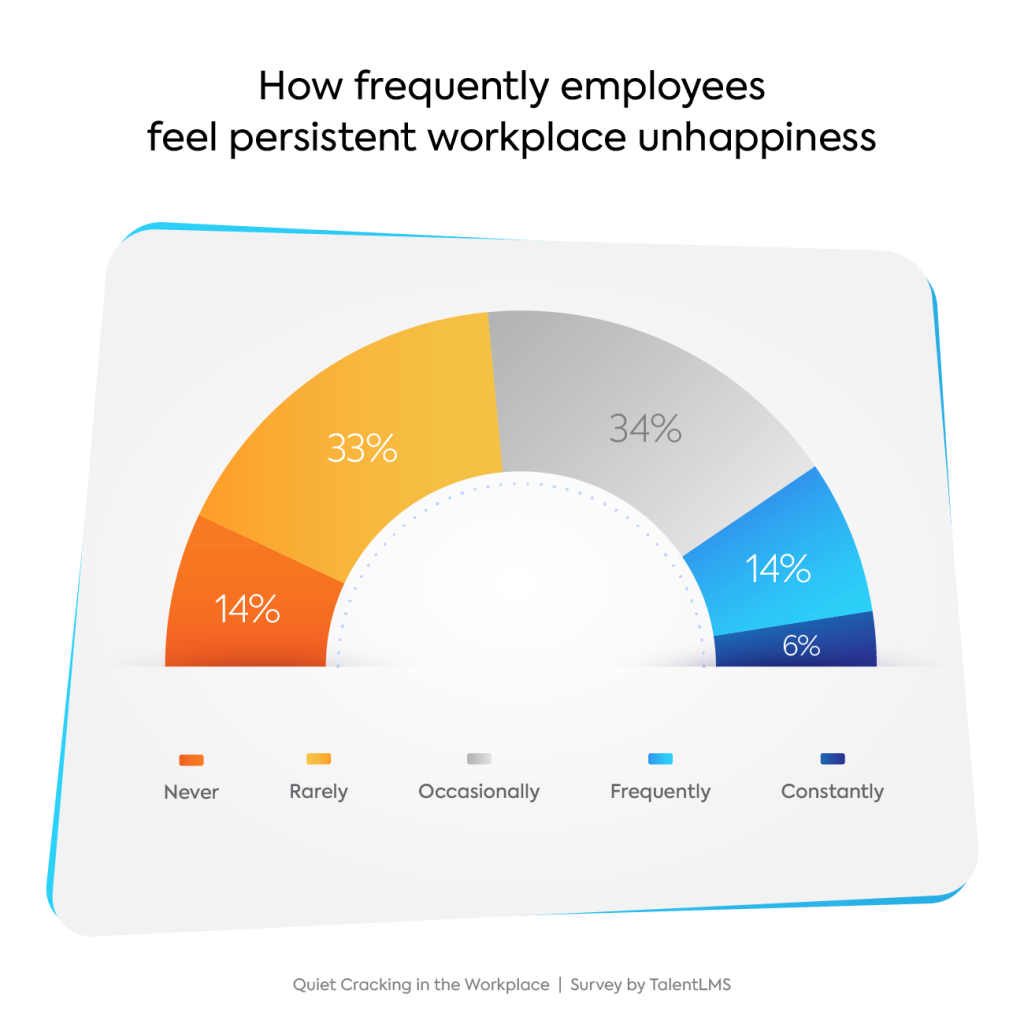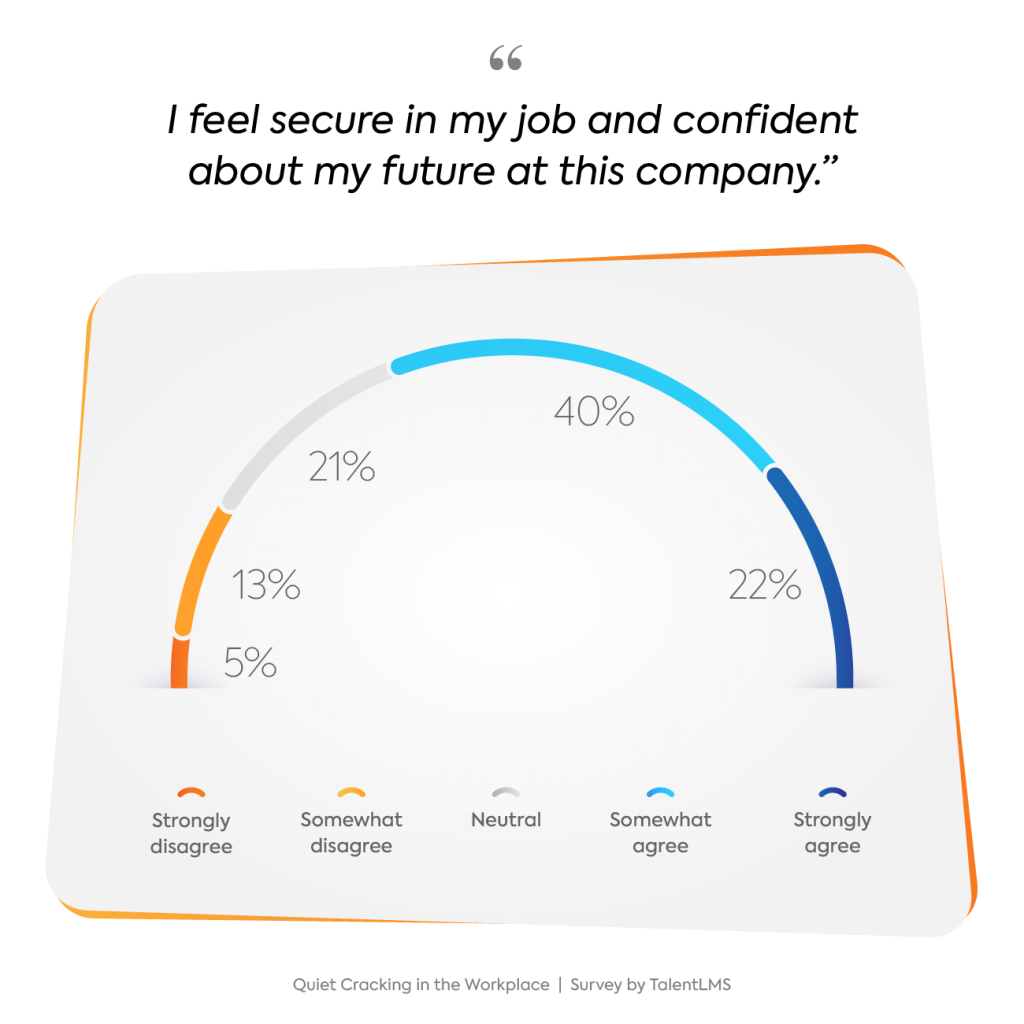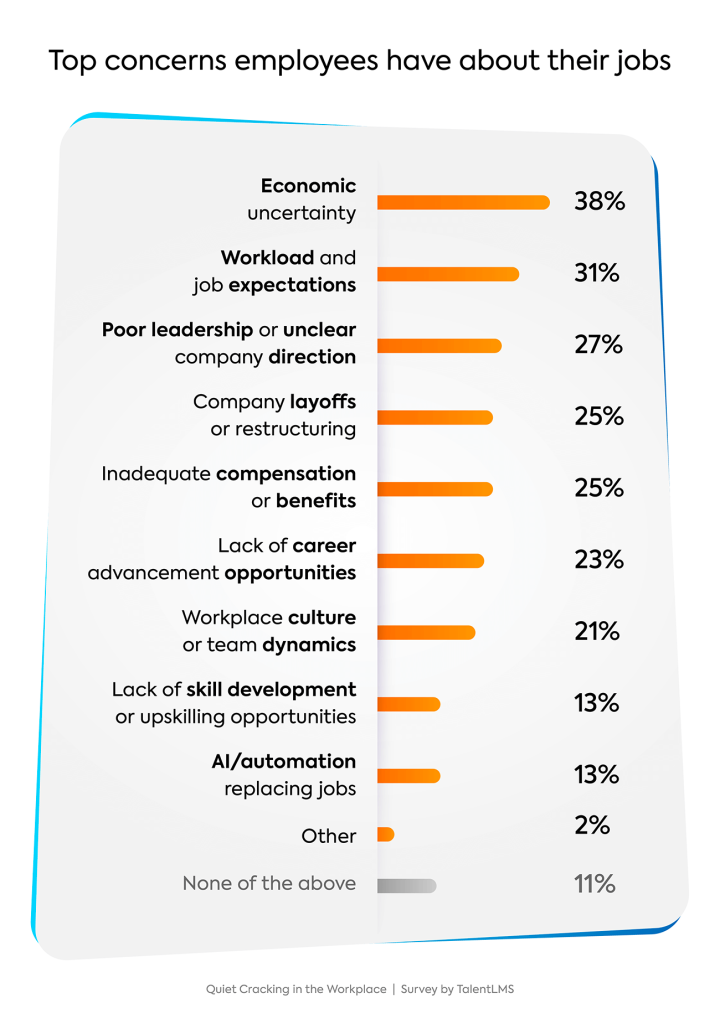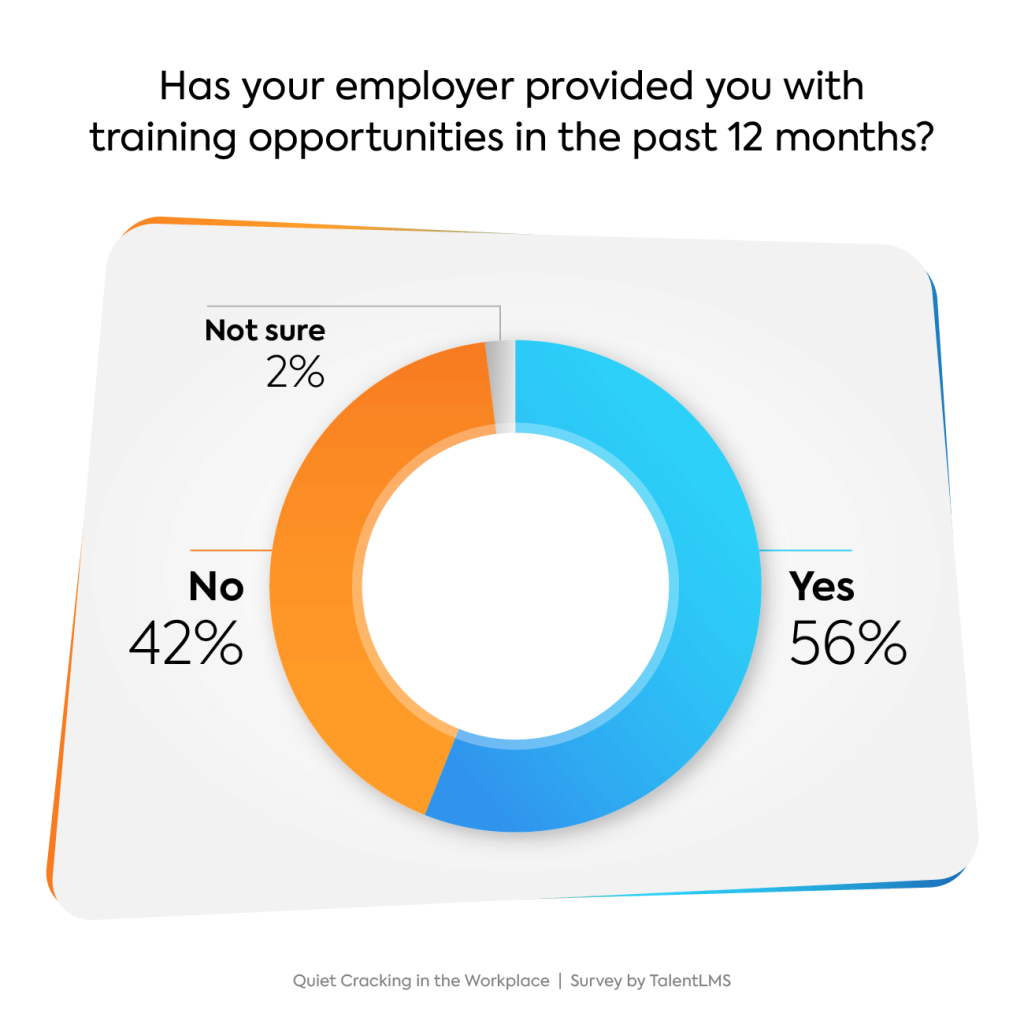New Research Reveals: Quiet Cracking: A Hidden Workplace Crisis
One in five employees say they’re stuck in a persistent state of workplace unhappiness, leading to disengagement, poor performance, or plans to quit—a phenomenon they acknowledge and we’ve coined “Quiet Cracking.» What helps? Consistent training, empathetic managers, and genuine recognition.

Key highlights
Job security is high—until you ask about the future
1 in 6 employees feel insecure about their jobs when tied to their company’s future.
“Quiet Cracking” reported by over half of U.S. employees
20% experience workplace unhappiness frequently or constantly, while 34% experience it occasionally.
Workplace learning impacts job security
Employees with no training are 140% more likely to feel insecure about their jobs.
Workplace unhappiness summary
In today’s workplace, something is breaking beneath the surface. It’s no longer just record-high disengagement or quiet quitting—it’s something deeper and harder to detect. Based on this research, TalentLMS calls it Quiet Cracking: a persistent feeling of workplace unhappiness that leads to disengagement, poor performance, and an increased desire to quit.
Quiet Cracking: a persistent feeling of workplace unhappiness that leads to disengagement, poor performance, and an increased desire to quit.
While job markets fluctuate and businesses adapt to post-pandemic realities, many workers are quietly struggling. Our latest research reveals over half of employees experience some level of Quiet Cracking. And 1 in 5 say it’s a frequent or constant state.

This report explores the underlying causes of Quiet Cracking, its impact on the workplace, and most importantly, what employers can do to turn things around.
What is Quiet Cracking?
In the aftermath of the pandemic, a new form of disengagement is taking root in the workforce—less visible than mass resignations (The Great Resignation), yet no less damaging. This concerns people who remain in their jobs and report feeling some kind of workplace funk. While headlines fixate on burnout and turnover, something quieter—and deeper—is unraveling behind office doors and computer screens: employees are silently cracking under persistent pressure.
54% of employees experience some level of Quiet Cracking compared with 47% who rarely or never feel this way.
Paralyzed by factors such as a tight jobs market, an uncertain economy, and a lack of career growth, employees fear their skills are outdated and face emerging threats such as AI. TalentLMS’s latest research uncovers this phenomenon, with the data to back the claim, that employees are “Quiet Cracking.”
Quiet Cracking is the erosion of workplace satisfaction from within. Unlike burnout, it doesn’t always manifest in exhaustion. Unlike quiet quitting, it doesn’t show up in performance metrics immediately. But it is just as dangerous.
Quiet Cracking is the erosion of workplace satisfaction from within.
It’s that feeling of disconnection, of not being heard, seen, or supported with growth or learning opportunities. Over time, it leads to disengagement, decreased productivity, and eventually, attrition. Gallup reports that disengaged employees are costing the global economy $8.8 trillion a year—that’s nearly 9% of total GDP lost to unhappiness at work.
Trends impacting Quiet Cracking
1. Job security now vs. the future
Employees may feel secure in their roles today, but ask them about tomorrow, and confidence drops sharply.
- 82% of employees feel secure in their current job
- Only 62% feel secure and confident in their future with the company
- Close to 1 in 6 employees (18%) are unsure if they have a long-term future where they are now.

Companies with retention initiatives or internal surveys that show their people are overall satisfied with their jobs might be at risk of having a false sense of security about their employees’ mindset. The disconnect we found in this data between overall job security and how employees feel about their future with their company indicates something that should alarm leaders—that people are not worried about losing their jobs but they don’t really feel like the employer-employee relationship is going to last.
82% of employees feel secure in their jobs today—but that drops to 62% when asked about their future with the company.
2. Economic pressures & overload
The top three concerns driving job insecurity are:
1. Economic uncertainty
2. Workload and unclear expectations
3. Poor leadership and company direction

And the insecurity doesn’t end here: employees who haven’t received training in the last year are 140% more likely to feel job insecure.
Employees who haven’t received training in the last year are 140% more likely to feel job insecure.
3. Managerial disconnect
Managers can be the lifeline—or the trigger. Their ability to support employees can make all the difference—and the numbers show where things stand.
- Overall, 62% of employees say their manager listens to their concerns, compared with 20% who feel their manager does not.
- For employees who say they are experiencing Quiet Cracking, 47% say managers do not listen to their concerns.
This shows a direct correlation between ineffective management and persistent unhappiness. Empathy and active listening matter more than ever.
4. Lack of training & recognition
Training and recognition are foundational to engagement. But many employees are going without. Overall, 42% of employees say they haven’t received any employer-provided training in the past 12 months.

Employees who frequently or constantly experience Quiet Cracking are 29% less likely to receive employer-provided training compared to those who never or rarely experience it.
- Employees not experiencing Quiet Cracking: 62% receive training.
- Employees frequently or constantly experiencing Quiet Cracking: 44% receive training.
Employees who frequently or constantly experience Quiet Cracking are 68% less likely to feel valued and recognized at work compared to their peers who do not experience Quiet Cracking.
- Employees not experiencing Quiet Cracking: 80% feel valued and recognized.
- Employees frequently or constantly experiencing Quiet Cracking: 26% feel valued and recognized.
In short: no growth, no recognition, no reason to stay.
Employee training isn’t just about skill-building; it’s an antidote to disengagement.
This isn’t just a retention issue. It’s a wake-up call. When people don’t feel like they’re growing, or worse—when their effort goes unnoticed or they feel stagnant in their job—they begin to quietly check out. And while the cost of disengagement may be invisible at first, it adds up quickly: in missed opportunities, stalled innovation, and rising turnover.
But here’s where the tide can turn.
When employee training is prioritized, it signals care, investment, and belief in people’s potential. It fuels motivation, builds capability, and creates a culture where people want to contribute—and stay. Training isn’t just about skill-building; it’s an antidote to disengagement. A catalyst for connection. And today, more than ever, it’s what people are asking for.
Future-proof your organization with skills-based training
Unlock your teams’ full potential with TalentLMS.
Sign up in seconds, test the platform forever, upgrade whenever.
The differences are staggering, and the implication is clear: workplace happiness is shaped by how supported and seen employees feel. Learning, as the data show, serves as a powerful antidote to Quiet Cracking—helping employees feel more secure about their jobs and future with a company.
The cost of Quiet Cracking
The business impact is both widespread and invisible—until it’s too late. Let’s take a closer look at the areas it affects.
Engagement
Employees quietly cracking are less likely to:
• Take on extra responsibilities
• Share ideas with team members
• Attend company team events
Productivity
• Disengaged employees slow down team momentum. They become bottlenecks, not bridges.
Culture
• When 20% of your team is quietly disengaging, it erodes trust and energy for the rest.
Retention
• Quiet Cracking employees are significantly more likely to be actively job hunting—even if they haven’t said a word.
How to break the cycle
Quiet Cracking isn’t inevitable. It’s a call to action. Here’s how organizations can prevent or reverse it.
Quiet Cracking isn’t inevitable. It’s a call to action.
1. Double down on learning & development
Training is more than a skill-building tool. It’s a confidence booster.
- Employees who received training in the last 12 months are 140% more likely to feel secure in their jobs
- They’re also more likely to feel valued
Take action:
- Offer structured, ongoing learning paths
- Let employees choose some of their learning content
- Make time for learning—not just access
2. Train the managers who shape the culture
Leaders shape day-to-day experience. And many are struggling.
Solutions:
- Provide leadership training focused on empathy and listening
- Encourage regular 1:1s and feedback loops
- Make manager engagement a metric that matters
3. Recognize, regularly
Recognition is low-cost, high-impact. It’s one of the simplest ways to show people that their work matters. Yet, it’s often overlooked in the rush of day-to-day operations.
- 21% of employees don’t feel valued and recognized for their contributions at work
- Quiet Cracking employees are 152% more likely to say this
Ideas to implement:
- Peer-to-peer shoutouts
- Monthly recognition spotlights
- Tie recognition to values and goals
4. Set expectations and balance workloads
Clarity combats chaos. When people don’t know what’s expected or have too much on their plate, things break down.
- 29% of employees say their workload is unmanageable
- 15% don’t clearly understand their role expectations
How to respond:
- Review job descriptions regularly
- Audit workload distribution by team
- Equip teams with stress management tools
Conclusion
Quiet Cracking isn’t just a well-being issue—it’s a business issue. When employees quietly crack, they take productivity, creativity, and loyalty with them.
What employers should do next:
- Audit current engagement and training efforts
- Identify gaps in managerial support and recognition
- Start small with consistent feedback and learning programs
Addressing Quiet Cracking doesn’t require overhauling your entire strategy—but it does require listening, acting, and investing.
About the survey
This TalentLMS survey was conducted online in March 2025 with 1,000 U.S. employees across industries. Minor discrepancies in total figures may occur due to rounding.
More workplace research by TalentLMS
Train your people. Measure results. Drive growth.
TalentLMS gives you the tools to supercharge every step of your training.


